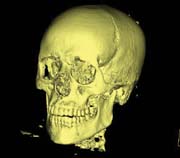The CBS television series "CSI" ranks among the most popular shows in America. So popular, in fact, that several iterations of the show have been created to satisfy public demand. While the popularity of CSI is not a surprise, what may be surprising is that the technology they use in the show - one form of which is often referred to as 3-D digital engineering - has transitioned from the bastions of popular science fiction and moved into real laboratories. This technology is hitting mainstream production and biopharmaceutical manufacturing in the form of complex scale models. 3-D digital engineering is now being used in a variety of applications and is impacting the world in ways never imagined.
Point Data Marketing Inc. (PDMI) is a leader in the field of 3-D digital engineering. The company rose to the forefront of this new technology by working on projects for organizations like the Smithsonian Institution, National Geographic, Chicago Magnesium & Casting and Edwards Lifescience. By using 3-D digital engineering to scan, replicate and then create three-dimensional models, a variety of applications are applied to that data.
There are many uses for 3-D digital information. In the case of a dinosaur fossil, each scanned bone can be replicated physically in plastic and reassembled for display in a museum so that everyone can appreciate the wonders of prehistoric life on Earth. Also, scanned 3-D digital information has been used to reassemble and create computer animations of how dinosaurs moved. PDMI has teamed with other innovators in the field, such as Virtual Surfaces Inc., to digitally analyze a 2,000-year-old Egyptian High Priest mummy and to analyze several ancient artifacts and specimens.
3-D digital engineering has been used in commercial applications as well, most commonly to evaluate parts during assembly. Manufacturers often spend considerable time and money determining what causes product malfunction. These companies have innumerable possible solutions: testing, retrofitting the manufacturing process, changing vendors, re-making molds, generating change orders - and still they are often unsure they are correcting the actual problem. By using 3-D digital engineering, parts within an assembly line are 3-D-scanned, registered to their original CAD files and interrogated showing where the part is in and out of tolerance. Instead of measuring a few hundred or a few thousand points, hundreds of thousands of points can be acquired and compared to a part's CAD file, resulting in dramatically enhanced parts-inspection accuracy.

Dr. Robert Morton, an expert in chemistry and engineering, leads the company's applications in the fields of inspection and mobile scanning. Today, perception is fundamental to the control, understanding and management of processes as complex as the human body. This is accomplished using a variety of techniques, including lasers, sound waves, magnetic fields and X-rays. In essence, 3-D digital imaging can be used to record the physical dimensionality of a component as well as understand the subtle chemistry impacting a process. For example, outside surfaces of valves, regulators and electrical components can be scanned and used to create a virtual environment for operators to control a process.

This technology was recently used to demonstrate that fossilized soft tissue can be perceived in 3-D. This is possible because the fossilization process frequently preserves the amount of original soft tissue that was present upon the specimen's death by the signature of trace elements left in the rocks. This led to the important discovery that fossils are geologic manifestations that contain both latent and physical attributes of life.
Stereoview Elemental X-ray Imaging is currently being used as a research tool in the recovery of ancient manuscripts where the text has been scraped away and virtually erased over time. The technology allows scientists and scholars to read ancient texts that many had thought were lost due to degradation.
The use of 3-D digital engineering is even being applied to biopharmaceutical applications. One idea under consideration entails systemic sampling techniques of manufactured biopharmaceutical goods that compare them against a computer-generated chemical structural design. From those samplings, purity levels are established and thus can be used as empirical audit data for regulatory compliance testing and validation of product quality.
Another application of 3-D digital engineering is in the area of gas containment vessels' quality, design and control. The same concepts of analysis in design and manufacturing of containers can be applied on both the micro and macro levels. Interest from petroleum and chemical manufacturers has been directed to PDMI.
The versatility of 3-D digital engineering is what resonates most in this day of technological wizardry. Whether analyzing chemical structural designs, evaluating and interrogating CAD files, or digitally recreating the skull of an ancient dinosaur, 3-D digital engineering is here to stay precisely because of that versatility. Moreover, its innovative approach to problem solving, which combines imaging, science, engineering and commerce to develop solutions, will change the way business and industry are conducted.
For more information on 3-D digital engineering, contact Brian Wilcox, president and chief executive officer, 6791 Talmedge Circle, Sparks, NV 89436; phone (775) 354-2233; or e-mail mobilscan@hotmail.com .